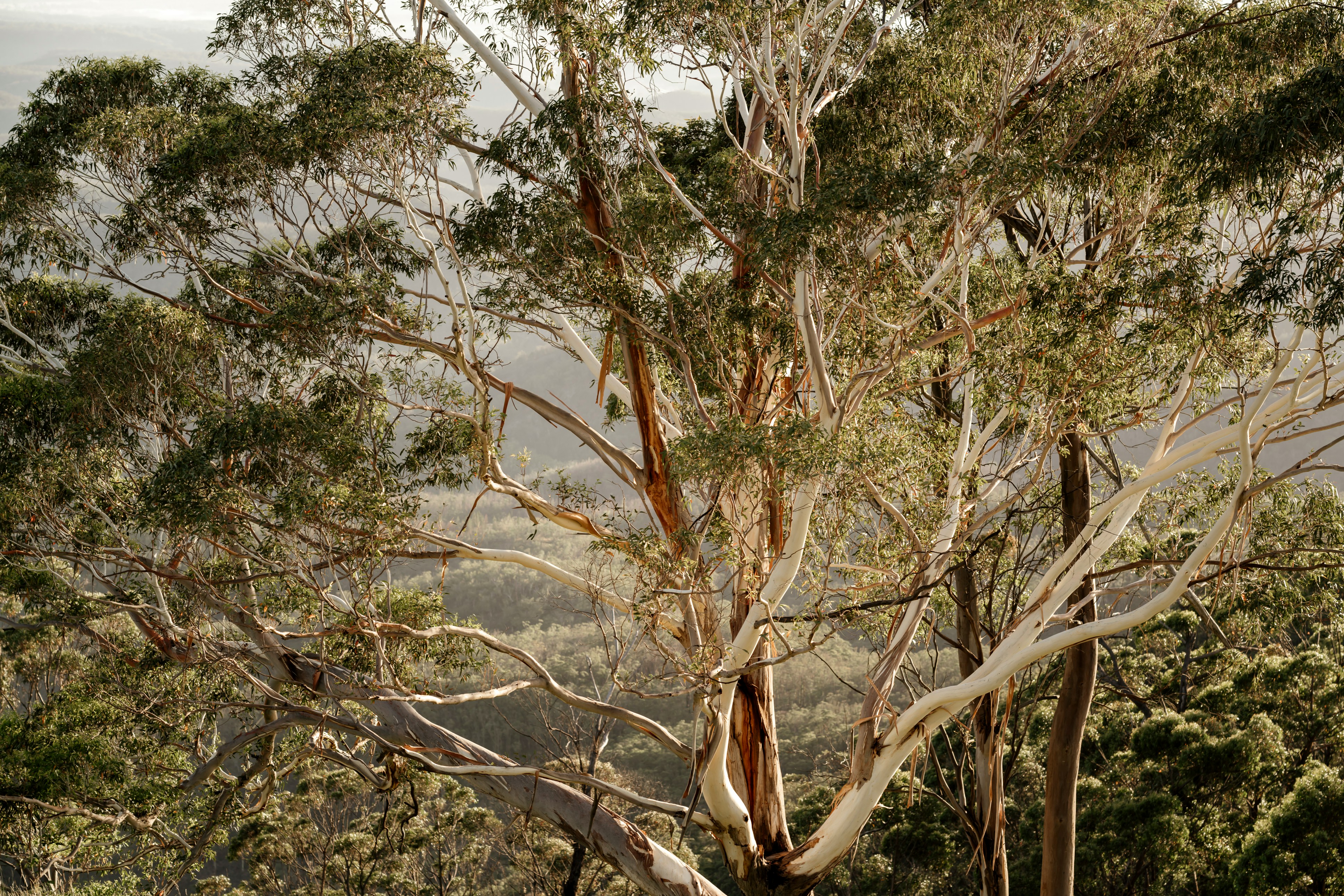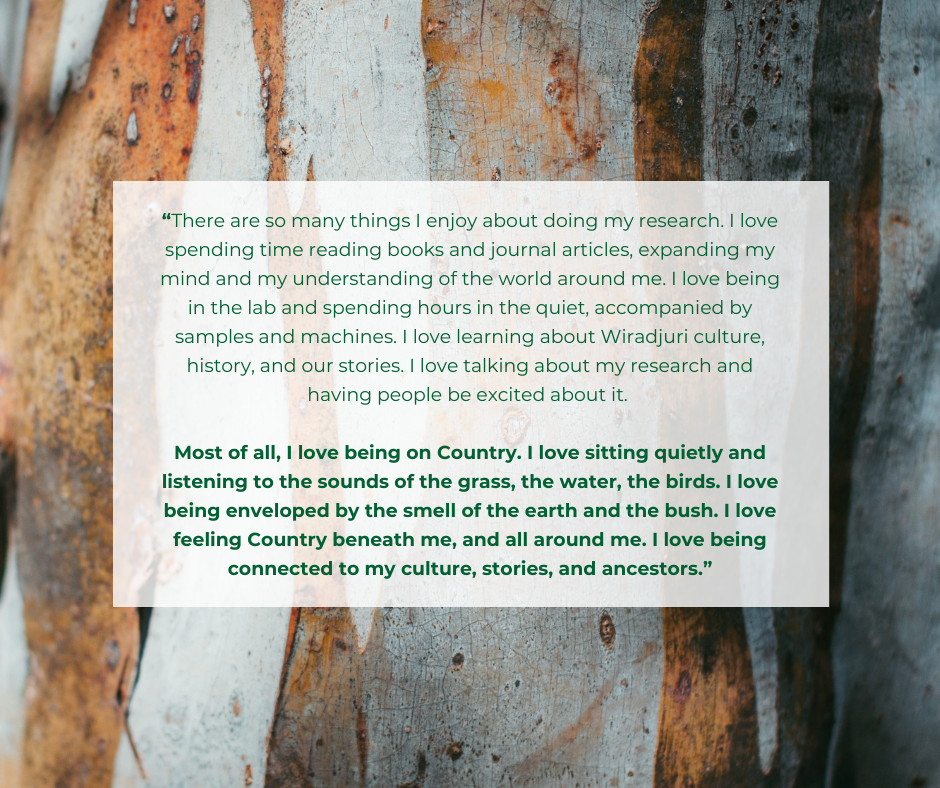'Always be respectful, always practice Yindyamarra': Exploring mining contamination on Wiradjuri Country

Image: Narissa J. Unsplash.
Future Earth Australia is pleased to profile the awarded Early Career Researchers and Professionals of its inaugural Opportunities Fund – Seizing Opportunities Grant.
This profile interviews Brianna Gordon, a Wiradjuri woman and PhD student at the Australian National University.
Brianna is one of 15 recipients of the 2023-2024 Seizing Opportunities Grant.
Disclaimer: This interview contains the names of First Nations people who have passed.
__
Congratulations on receiving a Seizing Opportunities grant! Can you tell us about your research and the project the grant will support?
Thank you very much; it’s an honour to receive the grant. I would like to start this interview with an Acknowledgement of Country. I acknowledge that I live and work on the beautiful, unceded lands of the Ngunnawal and Ngambri people. I acknowledge and thank their Elders past and present. I extend this same acknowledgement and thanks to the Elders of the lands of the readers of this interview, and any Indigenous readers themselves. I also give thanks to my Wiradjuri Elders for their guidance and support on my life’s journey.
My PhD research is titled Slow Disaster and Yindyamarra: A Two-Way research approach to legacy metal contamination on Wiradjuri Country. In this research, I am partnering with Wiradjuri Traditional Owners in the Tambaroora and Turon River area to investigate potential impacts of heavy metal contamination from the Australian Gold Rush on Wiradjuri Country (NSW).
For us, Country is not just the physical environment, the plants and animals, it is a deeply interconnected being that encompasses our histories, our stories, our communities, and our lives.
As part of this investigation, I must consider all aspects of the potential heavy metal contamination. This includes the gold-rush history on Wiradjuri Country, heavy metal quantity, chemical behaviour and response to environmental conditions.
This research stands out from other investigations of heavy metal contamination from gold mining because I am specifically interested in investigating what the potential impacts of this contamination might be for Wiradjuri people.
To do this effectively, I am partnering with Wiradjuri Traditional Owners to walk and yarn on Country to learn more about the history and stories of the Tambaroora and Turon River area.
As part of this yarning on Country, I hope to share in the knowledge of Wiradjuri Traditional Owners of the Tambaroora and Turon River area, which itself is an immense privilege. These yarns will be the main source of information for understanding how heavy metal contamination may be impacting Wiradjuri Country.
These yarns will also inform the creation of ethnographic and auto-ethnographic artistic works that will stand alongside a traditional PhD thesis. These place-based artworks endeavour to showcase the wider community, the stories of Wiradjuri spirit, environmental management, sustainability, culture, and the interconnectedness of Country in all aspects of our lives. These works will be displayed alongside excerpts from the yarns to share Wiradjuri culture, resilience, and sustainability with a wider audience.
The funds from this grant will support the production of these culturally informed artworks, covering material costs.
What do we currently know about metal contamination from gold mining in the Tambaroora and Turon River District, and on Wiradjuri Country?
It has been well established that the mining techniques used in the gold rush released heavy metals into the environment, including those that my research focuses on: mercury, arsenic, and lead. It has also been established that these heavy metals can still be found in the environment surrounding old gold mines and processing sites today.
However, there is still a lot we don’t know about heavy metal contamination in the Tambaroora and Turon River area. We also don’t know what the potential impacts of this heavy metal contamination might be on Wiradjuri Country in the area, which is the key focus of my research.
The potential impacts of heavy metal contamination depend on the concentration of the heavy metals in the environment and the chemical form they are in. There have been instances internationally where high environmental exposure to heavy metals has caused high environmental destruction, loss of life and has impacted Indigenous People’s ability to connect with their lands safely.
However, I don’t want any readers to be alarmed by this fact. We don’t know what, or even if, a potential environmental or health risk is present from these heavy metals in the Tambaroora and Turon River area, nor under what circumstances that risk might arise. This research is important as it will inform us if there is a risk and how we might safely manage it.

Can you describe the Two-Way methodology used in your project?
The Two-Way methodology is a decolonising research approach that weaves together Western and Indigenous Knowledge systems to create a ‘Third Space’ in which both systems can work together to achieve a mutually beneficial outcome whilst remaining true to Indigenous needs and protocols. Within the Two-Way Methodology, both Knowledge systems remain distinct and intact, and neither Knowledge system becomes dominant over the other. Instead, both systems ‘weave’ together, preserving integrity and acknowledging the contributions of both Knowledge systems.
In my research, I weave together environmental chemistry, yarning, and creative artworks to produce scientifically sound, innovative, culturally informed, and beneficial research. I love the use of weaving as a metaphor for Two-Way methodology.
Each strand we weave is distinctive; it is its own thing. Combining strands doesn’t destroy any individual strand but makes a stronger whole. In fact, it is the act of weaving these strands together that creates something beautiful and lasting.
Two-Way methodology itself in an academic context was born through broader works of decolonising academics and Indigenous-led methodology. Some leading academics in this space who have informed and shaped my work are Goenpul woman and academic of the Quandamooka people Aileen Moreton-Robinson, Torres Strait Islander man and academic Martin Nakata, and Ngāti Awa and Ngāti Porou, Māori woman and academic Linda Tuhwai Smith.
What have you learnt about working across different disciplines and methodologies so far?
My transdisciplinary work is wholly informed by a Two-Way methodology, meaning that the number one thing I have learned is that no discipline can take precedence over another. Every discipline I use has a wealth of knowledge and information that I am privileged to share, and there is still so much for me to learn. My duty as an interdisciplinary researcher is to understand each discipline and learn how they can be woven together.
However, as a Wiradjuri woman, I also understand that historically, Indigenous Knowledge Systems and Ways-of-Knowing have been dismissed, or not treated as valid forms of scientific research. When weaving together Western and Indigenous Knowledge Systems, I must be careful not to force Wiradjuri Knowledge into the confines of academics or a Western understanding of research.
I also must ensure that this research benefits the Wiradjuri people who are partnering in this research and their communities as much as, if not more so than it benefits me. Ultimately, when weaving together Western and Indigenous Knowledge Systems, I strive to practice Yindyamarra. Yindyamarra doesn’t have a direct English translation, but the closest simple translation is respect.
To be an interdisciplinary researcher in this space, to work with Indigenous Knowledge Systems, you must always be respectful; you must always practice Yindyamarra.
I have also learned that many people in academia are open to new ways of approaching a problem and are excited about interdisciplinary ideas. This gives me hope for the direction in which academia might be moving in the future.
Are there any people, thinkers or scholars who influence your work?
It is important to acknowledge that my work is influenced by at least 65,000 years of Wiradjuri Knowledge and millennia of Indigenous Knowledge from other parts of Australia and internationally. I want to acknowledge all Elders, past and present, who contributed to this work.
I heard a quote from Waanyi artist Judy Watson early on in my research journey where she described her artistic work as “cultural memory tied to place.” This quote was deeply impactful and shaped my approach of weaving creative works into my own research.
Michael Riley, a Wiradjuri and Kamilaroi photographer, is another artist who has inspired my work. He had an incredible talent for photographing Country in a way that tells a clear and evocative story.
I am extremely fortunate to have Professor Brenda Croft as a supervisor for my PhD. Professor Croft has a wealth of knowledge about Aboriginal and Torres Strait Islander artists, and she is also an extremely talented artist. Her photography is as beautiful as it is emotional, and she is fearless in exploring her own story and that of her family in her academic work. Her auto-ethnographic research that explores memory and culture is a particular inspiration for my creative works.
I also want to thank my other PhD supervisors, Dr Sara Beavis and Associate Professor Craig Strong, whose support and guidance have been incredible.
Stan Grant Jr’s writings, and particularly his discussions of Yindyamarra are impactful to my work and my personal life. I also want to acknowledge and thank his father, Stan Grant Snr, for his work to preserve and teach our language. Mandang guwu (Thank you).
Lastly, I want to thank and acknowledge the members of the Fenner Circle, which is a yarning circle where Indigenous and non-Indigenous students and academics come together to discuss Indigenous research and Indigenous matters in academics. I am proud to be a co-convenor of the Circle, and I am proud to call the members my friends. Mandang guwu to Dr Kate Harriden, Rosanna Stevens, Dr Rachel Gross, Nyssa Miller, Ellen Kirkwood, Sophia Cole, Fiona Goggins, Dr Kassel Hingee, Leila Noble, and all the other members who make the Circle, and my time as a PhD student, beautiful and fulfilling.
__
Future Earth Australia thanks Brianna Gordon for this wonderful interview, and looks forward to supporting her PhD research and beyond.
The Opportunities Fund would not be possible without the support of Granders Trust.
Find out more here.